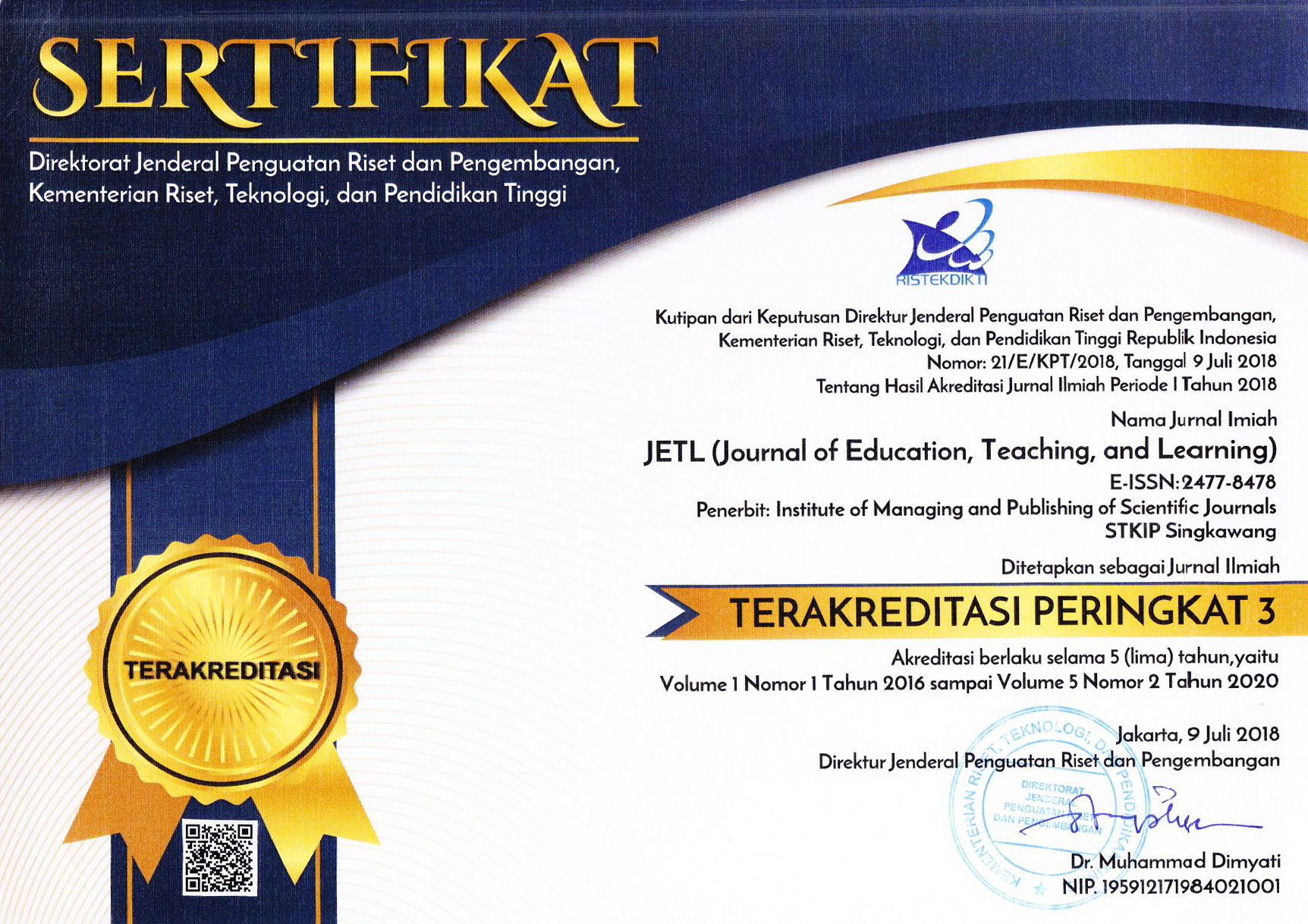Self-Directed Learning of the 7th Graders of SMP Bukit Asam Tanjung Enim
Abstract
Self-directed learning is an important component of the teaching and learning process. This study aimed to find out; (1) What is the level of self-directed learning of students and (2) What is the most dominant dimension of students’ self-directed learning. The quantitative study was used to answer the research objectives. Data were gathered through questionnaires. This study included 46 students from SMP Bukit Asam Tanjung Enim's 7th grade. To analyze the data, SPSS was used. The findings showed that the mean score for students' self-directed learning was 83.73, with a range of scores from 60 to 95. It means that students’ level of self-directed learning was average. Additionally, motivation received the students' highest average marks for self-directed learning. It revealed that motivation dominated all other factors, with self-monitoring, self-confidence, and self-control coming in last. Overall, the findings suggested that students should practice self-directed learning in the early stages of their education.
Keywords
Full Text:
PDFReferences
Abbad, M. M., Morris, D., & de Nahlik, C. (2009). Looking under the bonnet: factors affecting student adoption of e-learning systems in Jordan. The International Review of Research in Open and Distance Learning, 10, 2.
https://doi.org/10.19173/irrodl.v10i2.596
Akomolafe, M. J. (2013). Personality characteristics as predictors of academic performance of secondary school students. Mediterranean Journal of Social Sciences, 4(2), 657–664. https://doi.org/10.5901/mjss.2013.v4n2p657
Ames, C. (1992). Classrooms: Goals, structures and student motivation. Journal of Educational Psychology, 84(3), 261–271.
Assouline, S., Colangelo, N., Cole, V., Cutrona, C.E., & Russell, D.W. (1994). Perceived parental social support and academic achievement: An attachment theory perspective. Journal of Personality and Social Psychology, 66(4) 687. https://doi.org/10.1037//0022-3514.66.2.369
Basque, J. & Dare, S. W (1998): Environment and apparatus hip information. Journal of Distance Education, 13(1).
Bellanca, J., & Fogarty, R. (1991). Blueprints for Thinking in the Cooperative Classroom (2nd ed.). Palatine, IL: IR/Skylight Publishing.
Boekaerts, M. (2002). Motivation to learn. Educational Practice Series. International Bureau of Education.
Braun, V. & Clarke, V. (2006). Using thematic analysis in psychology. Qualitative Research in Psychology, 3(2), 77-101. https://doi.org/10.1191/1478088706qp063oa
Buelow, J. R., Barry, T., & Rich, L.E. (2018). Supporting learning engagement with online students. Online Learning, 22(4), 313–340. https://doi.org/10.24059/olj.v22i4.1384
Cadorin, L., Bressan, V., and Palese, A. (2017). Instruments evaluating the self-directed learning abilities among nursing students and nurses: a systematic review of psychometric properties. BMC Med. Educ, 17(1), 229. https://doi.org/10.1186/s12909-017-1072-3.
Chesebro, J. L., & McCroskey, J. C. (2002). Communication for Teachers. Allyn & Bacon.
Creswell, J. W. (2007). Designing and conducting mixed methods research. SAGE.
Darling, S., Kleiman, I., & Larocque, M. (2011). Parental involvement: The missing link in school achievement. Preventing School Failure, 55(3), 115-122. https://doi.org/10.1080/10459880903472876
Eisenberg N, Spinrad T. L., & Eggum (2010). Emotion-related self-regulation and its relation to children’s maladjustment. Annual Review of Clinical Psychology, 6, 495–525. http://dx.doi.org/10.1146/annurev.clinpsy.121208.131208
Fan, X. (2001). Parental involvement and students’ academic achievement: A growth modeling analysis. The Journal of Experimental Education, 70(1), 27–61. https://doi.org/10.1080/00220970109599497
Gani, l., & Amalia, S. (2015). Alat analisis data: Aplikasi statistik untuk penelitian bidang ekonomi dan sosial. CV. ANDI OFFSET.
Guay, F., Larose, S., Ratelle, C.F., & Senecal, C., (2005). Perceptions of parental involvement and support as predictors of college students' persistence in a science curriculum. Journal of Family Psychology, 19(2), 286-293. https://doi.org/10.1037/0893-3200.19.2.286
Hong, S., & Ho, H. Z. (2005). Direct and indirect longitudinal effects of parental involvement on student achievement: Second-order latent growth modeling across ethnic groups. Journal of Educational Psychology, 97(1), 32–42
Idris, F., Hassan, Z., Ya’cob, A., Gilb, S., & Awalc, N., A., M. (2012). The role of education in shaping youth’s national identity. Procedia - Social and Behavioral Sciences, 59, 443 – 450.
Kisa, A. & Ersoy, K. (2005). A study on the need for time management training is universal: evidence from turkey. Hospital Topics, 83(1). 13-19.
Knowles, M. S. (1975). Self-Directed Learning: A Guide for Learners and Teachers. Association Press.
Liu, Y. & Wang, H. (2009). A comparative study on e-learning technologies and products: from the East to the West. Systems Research & Behavioral Science, 26(2), 191–209.
Malinauskas R. (2004). The influence of social training on the social skills of sport pedagogues. Acta Paedagogica Vilnensia, 12, 61-68. https://doi.org/10.15388/ActPaed.2004.12.9616
Moeller. J. A., Theiler, M. J., & Wu, C. (2012). Goal setting and student achievement: A longitudinal study. Modern Language Journal, 96(2), 153–169. https://doi.org/10.1111/j.1540-4781.2011.01231.x
Ozerem, A. & Akkoyunlu, B. (2015). Learning environments designed according to learning styles and its effects on mathematics achievement. Eurasian Journal of Educational Research, 61, 61-80. http://dx.doi.org/10.14689/ejer.2015.61.4
Papalia, D. E., & Olds, S. W. (1990). Child‘s World: Infancy through Adolescense. McGraw-Hill Publishing Company.
Scarr, S., & Vander Zanden, J. W. (1984). Understanding psychology. Random House
Schraw, G., Flowerday, T., & Lehman, S. (2001). Increasing situational interest in the classroom. Educational Psychology Review, 13(3), 211- 224. https://doi.org/10.1023/A:1016619705184
Schroeder-Moreno, M. S. (2010). Enhancing active and interactive learning online lessons learned from an online introductory agroecology course. North American Colleges and Teachers of Agriculture Journal, 54(1), 21-30.
Terry, P. S. (2002). Effect of Time Management Practice on Self-Regulation, and Academic Self-Efficacy. [Dissertation of curriculum and instruction]. Virginal University
Turner, J. C. (1995). Influence of classroom contexts on young children’s motivation for literacy. Reading Research Quarterly, 30(3), 410–441.
Vinales, J. J. (2015). The learning environment and learning styles: A guide for mentors. British Journal of Nursing, 24(8), 454-457.
UNESCO. (2020). COVID-19 Educational Disruption and Response. https://en.unesco.org/themes/education-emergencies/coronavirus-school-closures
Weimer, M. (2002). Learner-Centred Teaching: Five Key Changes to Practice. Jossey Bass.
DOI: http://dx.doi.org/10.26737/jetl.v9i1.4326
Refbacks
- There are currently no refbacks.

This work is licensed under a Creative Commons Attribution-NonCommercial 4.0 International License.
Published by:
Institute of Managing and Publishing of Scientific Journals STKIP Singkawang
Sekolah Tinggi Keguruan dan Ilmu Pendidikan (STKIP) Singkawang
Address : STKIP Singkawang, Jalan STKIP - Kelurahan Naram Singkawang, Kalimantan Barat, INDONESIA, 79251
No. Telp. : +62562 420 0344
No. Fax. : +62562 420 0584
JETL (Journal of Education, Teaching, and Learning)
e-ISSN : 2477-8478
p-ISSN : 2477-5924

Editor in Chief Contact: [email protected] / Wa: +6282142072788
Publisher Contact: [email protected] / Wa: +6282142072788
Management Tools
JETL Indexed by:
JETL (Journal of Education, Teaching, and Learning) is licensed under a Creative Commons Attribution-NonCommercial 4.0 International License.











